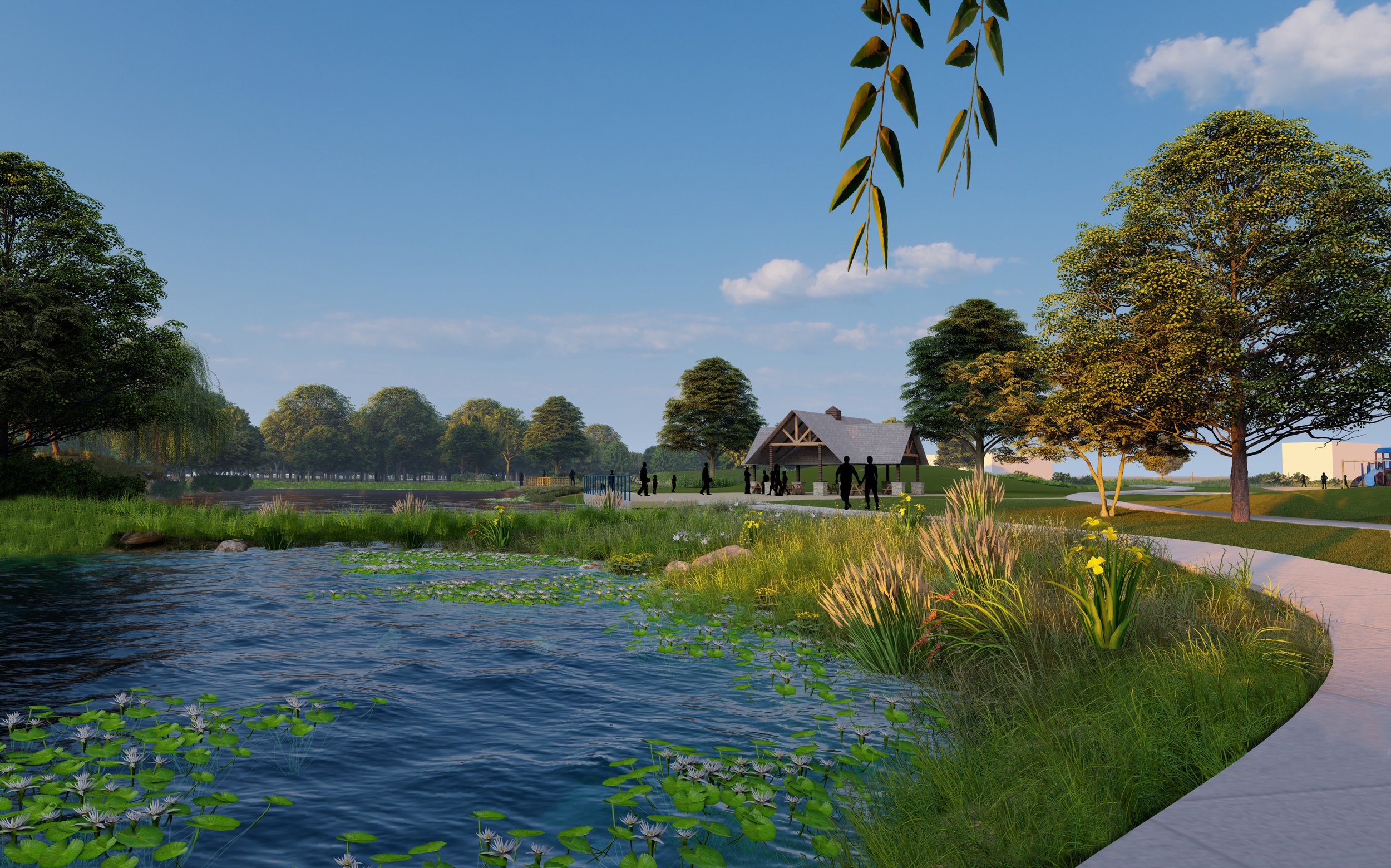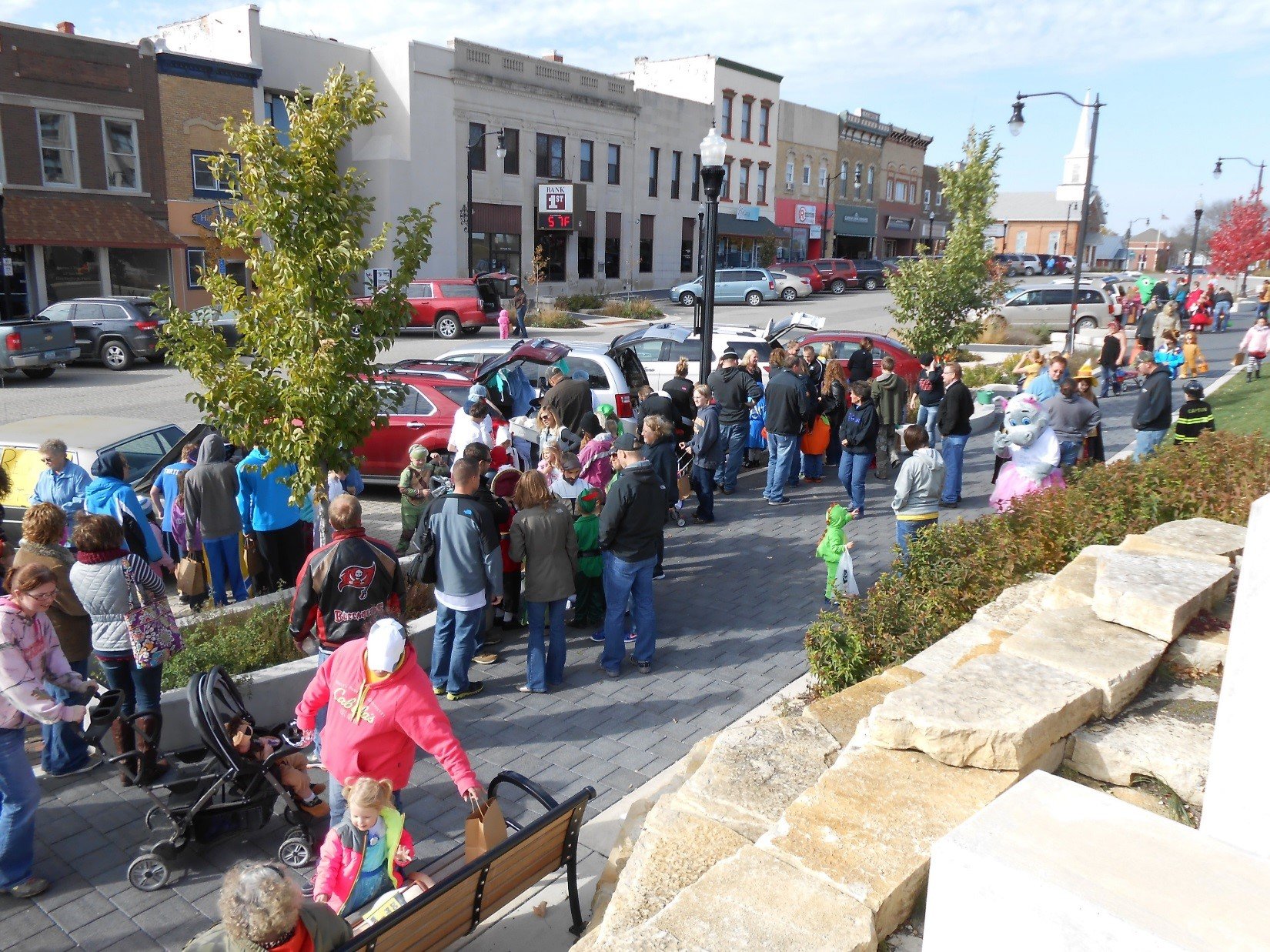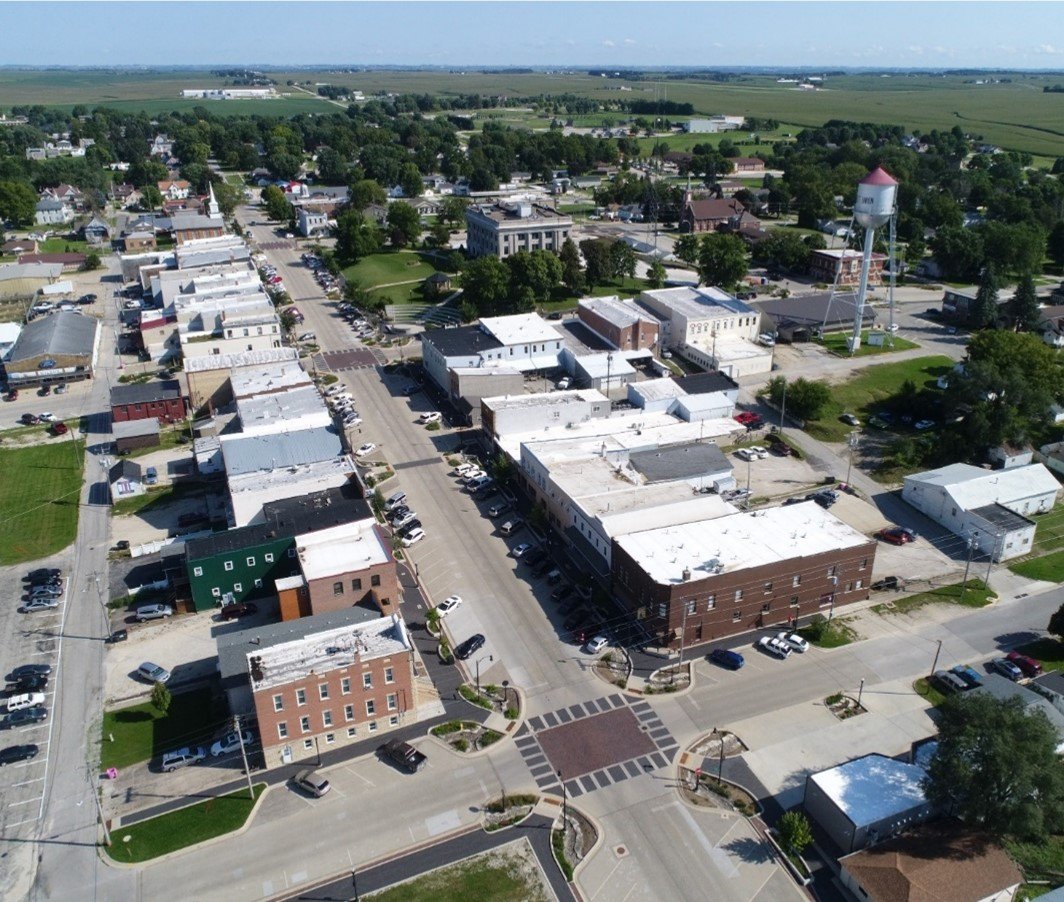Community-Scale Green Infrastructure Generates Optimal Performance
Advertisement
The fact that living green infrastructure (GI) strategies can provide significant tangible, measurable benefits is now widely accepted. Yet, GI remains the exception rather than the norm in building, site, and public infrastructure development/redevelopment in virtually all urban and suburban communities throughout North America. But what if communities embraced living system applications on every site? What would result from rapid, widespread, holistic integration of GI in entire neighborhoods, districts, corridors, campuses, towns, and cities? If more people understood the potential for GI to help alleviate the most pressing issues of the day, would they be more inclined to rapidly increase demand and therefore use?
Palmer Park Habitat Restoration, Detroit, MI, City of Detroit GSD, People for Palmer Park, Biohabitats. Photo: David Yocca, rendering by Ted Cook
Demonstration ecological habitat restoration of eighty acres of remnant woodland, prairie/savanna, and aquatic landscapes in historic 281-acre city park.
Bioretention to manage water on-site and provide stable hydrology for naturalized lake.
Stakeholder engagement, interpretive and education elements, research/monitoring part of public process.
An on-going program of the Green Infrastructure Foundation (GIF), which I Chair, has been attempting to answer these questions for nearly a decade. GIF’s Green Infrastructure Charrette Program is helping community groups to learn about and better understand GI performance at a community scale. While the term “green infrastructure” is used to describe many things, ranging from regional greenways and parks to green buildings, for the purposes of this program, GI refers to nature-based practices that:
integrate human-engineered and managed living systems (plants and soil primarily) into the built environment
rely upon natural processes (evapotranspiration, nutrient cycling, local geology, etc.)
provide a broad range of value-adding ecosystem services and economic benefits
Green roofs and walls, bioswales/rain gardens, urban trees, permeable pavement systems, wetlands, and native/naturalized landscapes are all examples of GI that provide multiple benefits, many of which are amplified when scaled up to an entire community.
Advertisement
Multiple Benefits of GI
The benefits achieved by GI systems, confirmed by on-going regional research and case studies, have been well-publicized. Many people have witnessed GI applications in their community or have seen them in publications. While some realize one or even several GI performance attributes, few understand the full spectrum of benefits and values they offer if conceived, constructed, and operated/maintained/stewarded accordingly, especially at a community scale. Issues and associated public and private benefits include:
Water
Urban runoff, localized flooding, degradation of lakes, streams, and rivers, drinking water shortages, and catastrophic storms are all increasing in severity with increasing temperatures and stochastic weather events. GI helps transpire, slow, cool, cleanse, and infiltrate rainwater.
Lafayette Green, Detroit, MI, Greening of Detroit, Kenneth Weikal Landscape Architecture. Photo: David Yocca
More than eight hundred pounds of herbs and vegetables are grown and donated to local food bank.
Diverse array of vegetables, herbs, flowers, heirloom fruit trees, vines, and berries create habitat for pollinators.
GI practices (bioswales, low-input turf, water-conserving irrigation system) manage water as a resource.
Energy/Conservation, Climate Mitigation/Adaptation
To optimize transition from fossil fuels to renewably sourced energy, GI cools urban surfaces, reduces ambient temperatures, and mitigates other impacts associated with rapidly changing climates.
Urban Ecology/Regenerative Agriculture
GI can be calibrated to local ecologies and hydrological regimes to provide new or restored habitat for native flora and fauna, as well as additional space for growing vegetables, herbs, fruits, and other agricultural products.
Economic/Prosperity
Living surfaces add beauty, durability, and human engagement to urban spaces, stabilizing property values and creating opportunities for new local business enterprise.
Health, Well-being, and Equity
Urban dwellers have limited access to nature, and frontline communities that experience the most immediate and worst impacts of climate change are most often communities of colour, Indigenous, and low-income. Most importantly, GI helps restore and improve conditions for all people to thrive, be more connected to the outdoors, and access to better living, working, learning, and healing spaces.
Advertisement
Green Infrastructure as a Cornerstone of a Community Climate Adaptation Strategy
Properly implemented GI is an essential element of climate adaptation strategies for any community, especially when a holistic, integrated, transparent planning process is employed. GI solutions should be prioritized and accelerated at community scale, based upon their innate qualities:
$54M Environmental Impact Bond to Finance GI, Buffalo, NY, Buffalo Sewer Authority, ECT
Buffalo Sewer Authority and the City of Buffalo issued the largest U.S. Environmental Impact Bond to-date.
The City is implementing Green Infrastructure throughout Buffalo to tackle stormwater challenges, respond to the climate emergency, and advance social and environmental justice.
Flexible and adaptable to meet the local requirements of communities. Infinite variations can be calibrated for local conditions and context.
Higher employment to capital ratio compared to grey infrastructure projects, investing more on people and local business enterprise; an ideal part of a ‘just transition’ away from fossil fuels and workforce development in the emerging new green economy.
Decentralized, many projects working together as part of a network, creating greater resiliency.
Shorter implementation period for GI projects, which can be rapidly and incrementally implemented due to their decentralized nature.
Function improves over time; as vegetation matures, soil biology improves, and ecosystem succession occurs, GI improves in effectiveness and is appreciated as an asset with time.
Requires little to no energy inputs relying largely on solar energy and natural processes to provide its functions.
Climate change mitigation benefits including carbon sequestration in plant biomass and soils, and reducing energy use directly and indirectly.
More livable communities through enhanced function and beauty could also increase public support for more immediate action on climate adaptation.
Valuing the Benefits of Green Infrastructure
While achieving these benefits is becoming increasingly urgent, communities need to better understand the economic implications of enacting policies and programs to regulate and incentivize GI. Even when GI strategies are considered, they are typically only evaluated for one or several performance attributes (i.e., stormwater management), and typically not from a long-term capital investment payback perspective. Part of GIF’s GI Charrette Program is a tool that performs an aggregate-level economic analysis of community-scale GI applications. The GI Cost-Benefit Matrix lists ten distinct types of GI and is updated with current local values for each through local investigation. A community engagement process (charrette) is used to take a real location and develop a scenario that incorporates a full suite of GI, which is then used to project quantities, costs, and performance benefits. The analysis summarizes aggregate costs (construction and annual maintenance), describes benefits (stormwater, increased longevity, recreation, etc.) and calculates an approximate payback for the investment.
The matrix is an aggregate-level tool - meaning it is not intended to analyze a specific project, but to start a discussion and inspire further study and subsequent action. The tool is limited in that many benefits (i.e., improved health, reduced grey infrastructure) are not monetized but could have a significant impact at scale. Therefore, the studies are conservative and high-level, although the results always generate surprisingly substantial evidence to rapidly embrace community-scale GI. Results range widely depending upon the scenarios, applications, and other variables, but all to-date indicate positive return on investment, creation of new green jobs, and many benefits that could not be quantified.
Advertisement
Best Practices for the Community-Scale Use of Green Infrastructure
The greatest benefit from GI comes from holistic applications that address multiple issues within the same space. These opportunities increase significantly when scaled up to districts, corridors, neighborhoods, and cities. The following nine Community-Scale Green Infrastructure Best Practices were distilled from the past several years of GIF’s Charrette Program and on-going research:
1. Complete and Green Streets and Corridors
Optimize the entire public realm with GI integrated with walkable human-scale design, district energy strategies, and local art/craft.
2. Engage the Public
Involve all stakeholders in the process of developing GI strategies and plans; provide compensation to low-income stakeholders to support their participation; include locally appropriate process leadership.
3. Support Urban Agriculture
Integrate crop production into biodiverse GI to provide healthy local food in addition to other ecosystems services in the same space.
4. Improve, Expand and Connect Existing Green Spaces Where Possible
Re-purpose strategic under-utilized/vacant parcels to connect GI features with parks/trail corridors as improved community amenity.
5. Optimize Biodiversity and Resilience
Utilize native/locally adapted plantings, provide ecological connectivity, and incorporate other habitat elements to improve and enhance biodiversity and habitat quality.
6. Incorporate Job Training and Workforce Development into GI Plans
Build capacity to implement and maintain GI at-scale over time as a new green enterprise, align with clean energy and other emerging resiliency sectors.
7. Achieve Environmental Justice Goals Through Green Infrastructure
Prioritize GI investment in low-income and frontline communities experiencing the “first and worst” consequences of climate change combined with decades of disinvestment, typically Black and Brown neighborhoods placed in the least desirable areas of cities, often with high exposure to climate impacts like flooding and poor air quality due to adjacent land uses.
Advertisement
Sustainable Square MileTM, West Woodlawn neighborhood, Chicago, IL, BIG! Photo: Blacks In Green
BIG is implementing a GI retrofit of an entire neighborhood through the holistic integration of clean energy/water/food/ecology solutions as a model of the Sustainable Square MileTM
BIG’s vision creates a buffer of resilience for Black communities by generating health and wealth through economies in clean energy, green infrastructure, affordable housing, heritage tourism, and waste management.
8. Value Green Infrastructure as Assets
Include GI and natural/ecological assets in community asset evaluation to ensure their protection and insurance coverage are factored into budget planning to maintain levels of ecosystem resilience that secure long-term conditions to sustain human health and well-being.
9. Leverage Private Sector Investment
Use public resources to incentivize investment in GI practices on private properties that provide long-term benefit and value to the public; aggregate public and private funds to scale up GI implementation for mutual benefit and economic return.
David Yocca, FASLA, RLA, GRP, is a Consulting Landscape Architect/Ecological Planner and Board Chair for the Green Infrastructure Foundation (GIF).
The Green Infrastructure Foundation (GIF) partners with communities to shape healthy, resilient, and sustainable places using living GI. The summary reports from the GI Charrettes and other resources are all accessible on GIF’s website. To learn more about how GIF and the Green Infrastructure Charrette Program can help your community to advance with GI practices, contact David Yocca.










